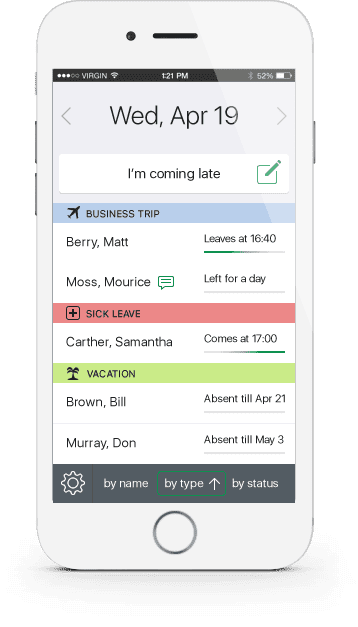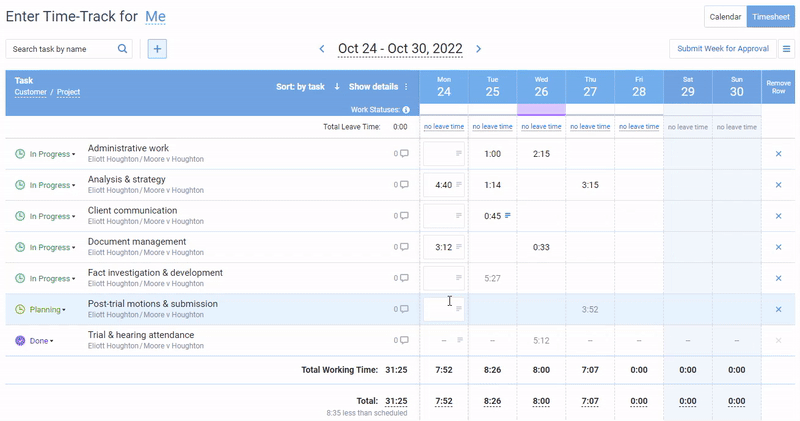Is your team full of workaholics and overachievers whose profession is taking over their lives, leaving them little room to breathe, let alone relax?
Even if career is a priority for your employees, the lack of days off puts their health and well-being at risk.
As data shows, forcing employees to go on vacation helps to increase creativity by 33%, overall happiness – by 25%, and productivity – by 13%. Hence, a mandatory vacation policy is definitely worth trying out – it makes maintaining a proper work-life balance a tad bit easier.
Stick around as we unpack the essentials of this compelling approach and explore how it can boost productivity, enhance employee well-being, and even save your company money (no matter what kind of workplace environment you have).
- What Is Mandatory Vacation Policy?
- What Makes Mandatory Vacation Policy Vital
- Benefits for Employers
- Benefits for Employees
- How Does Mandatory Vacation Compare to Other Types of Leave?
- Jobs That Benefit from Mandatory Vacation Policy Most
- Mandatory Vacation Policy: Disadvantages
- How to Make It Work
- Conclusion
What Is Mandatory Vacation Policy?
Mandatory vacation is a company policy that requires employees to take a certain amount of time off each year. And while it may sound like a dream come true for some people, it’s not just about giving employees a break for fun and relaxation – there are practical reasons behind this policy.
What Makes Mandatory Vacation Policy Vital
While the demand for continuous mental engagement and development is on the rise in modern workplaces, such things as engagement and learning require regular rest time in order to last long-term and bring positive outcomes.
However, today’s workforce tends to neglect its need for rest. For instance, US employees left 768 million accrued PTO days unused in 2018 alone (source). As a result, they expose themselves to a higher risk of chronic stress (aka burnout), which ultimately leads to exhaustion, mental health problems, poor productivity, and lower quality of life.
Burnout is costly not only for employees themselves but for employers too.
- According to Spill, workers’ mental health problems cost UK companies £2.646 per year on average.
- As noted by Business Insider, US companies lose about $1.9 trillion each year due to employees’ poor engagement and lost productivity (which can be a result of burnout along with other factors).
Thus, it’s important to address the issue of employee burnout, and a mandatory vacation policy might be a good measure to start with.
Benefits of Mandatory Vacation for Employers
- Productivity boost: When employees return from a vacation, they’re often more refreshed, focused, and ready to tackle their tasks with renewed energy. Thus, by encouraging your team members to take regular breaks from work, you actually make them more productive.
- Reduced risk of burnout: Burnout is a real risk in many professions, and it’s costly. It leads to lower productivity, higher absenteeism, and increased turnover. Mandated vacations take you one step closer to eradicating the problem of burnout and help to keep your workforce healthy and engaged.
- Enhanced creativity: Sometimes, the best ideas come when you’re not trying so hard. Time away from the office allows employees to relax and think freely, which can spur creativity and innovative thinking when they return.
- Stronger workplace morale: When employees know that the company cares about their well-being, it boosts their morale. And not so many things demonstrate that kind of care better than a mandatory vacation policy – it shows that you value work-life balance and employee health, and do your best to create a more positive work environment.
- Better employee retention: Happy employees are much less likely to leave. Regular vacations can improve job satisfaction and make employees feel valued. This, in turn, reduces turnover and saves your company money in recruitment and training costs.
Benefits for Employees
- Better mental and physical health: Taking regular breaks from work is a must for maintaining your overall well-being. Time away from the office allows you to unwind, de-stress, and recharge your mental batteries. Plus, engaging in leisure activities or simply relaxing can significantly improve your physical health, e.g., lower blood pressure and reduce the risk of stroke and heart disease (source).
- Better work-life balance: A proper balance between your personal life and career is essential to feel fulfilled and happy. A mandatory vacation policy gives you a chance and time to pursue hobbies, spend quality moments with family and friends, and simply enjoy life outside of work. It helps not to feel as if you are tethered to the job, which makes it easier for you to become a more content and well-rounded individual.
- Higher job satisfaction: For the majority of people, their jobs consume a massive portion of their lifetime. Hence, nothing can be so frustrating as to feel constantly stressed at work and dissatisfied with the workplace. Therefore, when your company encourages you to take time off (and treats you well), you are more likely to feel valued and appreciated. This translates to higher job satisfaction, which can enhance not only your job performance and engagement but also your overall life experience.
How Does Mandatory Vacation Compare to Other Types of Leave?
When it comes to leave policies, mandatory vacation stands out from the pack.
Unlike sick leave, parental leave, or any other leave type that is driven by necessity, mandated vacation implies a proactive approach to promoting employee well-being and preventing burnout. In other words, it doesn’t come as a reaction to certain life events (e.g., a disease, military service, childbirth, etc.). It aims to minimize the risk of healthcare problems among employees, reduce health-related costs for your business, and promote overall team productivity.
Another obvious and essential feature of mandatory vacation policy is that it’s compulsory.
For example, regular vacation policies allow employees to choose whether to use up all their accrued time off per year or not and how many days off in a row to take. In contrast, under a mandatory vacation policy, employees must take a particular amount of leave time within a predefined period – they simply cannot say no.
These qualities make mandatory vacation policy an excellent PTO benefit for high-intensity environments where the risk of overwork and mental exhaustion is at peak.
Jobs That Benefit from Mandatory Vacation Policy Most
- Healthcare providers: These heroes are on the front lines, dealing with life-and-death situations every single day. A compulsory break could help them regain balance and continue saving lives with that razor-sharp focus.
- Air traffic controllers: These professionals juggle the safety of thousands of passengers daily. It’s like playing an intense game of chess, except the pieces are airplanes. Mandatory vacay? Yes, please!
- Firefighters: Running into burning buildings isn’t just physically taxing – it’s mentally exhausting too. Mandatory downtime is sure to help these brave souls decompress.
- Social workers: Helping people navigate complex and often distressing life situations can take an emotional toll. A secured annual break can provide a much-needed mental health boost.
- Journalists: Chasing stories and meeting tight deadlines keeps adrenaline levels up but can lead to burnout. Stepping back can help them continue delivering those hard-hitting pieces.
- Stockbrokers: Navigating the volatile world of finance can be nerve-wracking. Scheduling a mandatory break from the frantic pace of the stock market could do wonders for their mental and physical well-being.
Mandatory Vacation Policy: Disadvantages
While mandatory vacation policy is an excellent measure for burnout prevention, it has its share of disadvantages that are worth considering:
- Reduced flexibility: When vacation time is enforced, employees have fewer opportunities to choose when to take their breaks. This lack of flexibility is particularly inconvenient for those who prefer to take vacations based on personal or family commitments.
- Risk of resentment: Believe it or not, not everyone likes to be told when to relax. Forcing employees to take time off can make them discontent if they want to have autonomy over their own leave schedules. As a result, this can weaken team morale and create a sense of mistrust.
- Requires careful planning: Mandatory vacations can sometimes lead to a mismatch in team availability. If key members are away at different times because of enforced leave, it can impair collaboration and productivity, slowing down projects and affecting overall results.
How to Make It Work
1. Create a comprehensive mandatory vacation policy
A proper policy is the best way to keep your vacation management processes well-organized and stay in control of team absences. Creating one takes just a couple of steps:
- Define your goals and objectives: Why are you implementing a mandatory vacation policy? Maybe it’s to reduce burnout, increase productivity, or boost employee morale. Whatever your reasons, having clear goals will guide the rest of the process.
- Research local labor laws and regulations: Trust us, you don’t want to skip this step. Understanding what’s legally required in terms of paid holidays and unpaid time off will save you a lot of hassle down the road. Plus, it ensures you’re being fair and compliant.
- Determine the specifics of your policy: How many days will be mandatory? Will there be any blackout periods during which vacations can’t be taken? Setting these parameters will help you create a structure that’s easy to follow.
- Create the guidelines: Outline how employees can request time off and the approval process. Keep it straightforward and transparent to avoid any confusion. Pro tip: an FAQ section can be super helpful for answering common questions.
- Communicate the policy effectively: Don’t just send a long email and call it a day. Hold a meeting or a series of workshops to explain the benefits and answer any questions. This gets everyone on board and excited.
- Review and revise: Policies should be living documents. Get feedback from employees and make adjustments as needed. A policy that works well for your team this year might need tweaks next year
2. Make it as flexible as possible
It may sound counterintuitive but mandatory vacation policy doesn’t have to be rigid. There are a few simple ways to infuse it with some flexibility (to employees’ great pleasure):
- Let employees choose their dates: Allowing your team members to pick their vacation slots can greatly reduce stress. It gives them control over their time off and ensures they can plan around personal commitments.
- Offer floating holidays: Instead of sticking to a rigid set of public holidays, you may opt for floating holidays that will allow your team members with different cultural or personal needs to take time off during festivals or events that are important to them.
- Encourage mini-breaks: Sometimes, people need a short recess more than an extended leave. Allowing mini-breaks – like extended weekends or a day off here and there – can help employees decompress periodically, maintaining their energy levels and focus.
3. Use a reliable leave tracking system
Imagine trying to keep tabs on everyone’s vacation days with a messy spreadsheet or, even worse, a notepad. Not only is it stressful, but it’s also ripe for errors.
A robust leave tracking system will help you keep everyone’s precious time off accounted for and make sure your company isn’t left in a lurch by surprise absences.
A great leave tracking system to consider? Try actiPLANS!
It automates leave management processes, making them a breeze for every party involved.

Here are some of the features that will help you manage mandatory vacations with ease:
- Create multiple custom leave types and set individual accrual and approval rules for them.
- Schedule leave time for employees on an intuitive visual timeline or let your team members set preferable vacation dates and approve them afterward.
- Use the mobile app to request time off on the go, write absence comments, and check on colleagues’ availability.
- Run in-depth reports to inform your resource management decisions and plan team absences in advance.

Check out actiPLANS in action – sign up for a free 30-day trial today.
4. Plan workforce capacity in advance
Picture this: It’s the middle of a big project, and suddenly two of your top performers are enjoying their mandatory vacations. Not great, right?
Planning ahead helps avoid this scenario. It ensures consistent productivity and helps not to overburden the remaining team members. Plus, it guarantees that your clients and customers won’t notice a dip in service levels. It’s all about keeping the ship sailing smoothly.
Here’s what you can do:
- Analyze past trends: Review historical data to understand your business’s busy and slow periods. This will give you an idea of when you can afford to have more people on vacation.
- Set blackout dates: Define critical periods during which no vacations are allowed. Communicate these dates to the team well in advance.
- Develop a succession plan: Identify who will take over critical tasks in someone’s absence. Cross-training employees is incredibly valuable here.
- Use a proper task management tool: A multifunctional software solution like actiTIME can help you plan out tasks, set deadlines for them, allocate work to employees, and track ongoing progress with ease and grace. Besides, you can integrate it with actiPLANS to combine extensive work management functionality with time off tracking and take your capacity planning experience to a whole new level.
- Communicate early and often: Keep the lines of communication open. Encourage team members to book vacations as early as possible and make plans visible to everyone.
- Have a backup plan: Always have a contingency plan for emergencies. Whether it involves temporary hires or freelancers, it’s good to have that extra layer of security.

Conclusion
In sum, in high-intensity workplace environments, a mandatory vacation policy is not just nice to have but a crucial strategy for enhancing employee well-being and productivity. And though initial policy adjustments may require effort, the long-term benefits surely make it a no-brainer.
If you’re looking for an efficient way to manage your mandatory vacation policy seamlessly, look no further. Start using actiPLANS today to ensure that your team gets the rest they deserve, keeping your workplace dynamic and thriving.
Don’t wait – take the first step towards a more balanced and productive work environment now.



